Performance
Lens
The 13x lens is surprisingly good. Despite the wide zoom range, there’s no noticeable distortion—no barreling or fisheye look fully wide, no pincushion distortion zoomed in. Chromatic aberration likewise doesn’t seem to be an issue anywhere in the zoom range, and if there’s any vignetting or portholing, I didn’t see it (I neglected to test for it specifically, but I didn’t see any during my time with the camera).
At this price point, it’s fairly likely that the lens does suffer from these maladies to some degree, but that Panasonic is digitally correcting them before recording or displaying the image. That’s one of the benefits of building a lens into a camera: the camera can have intimate and detailed knowledge of the lens’s performance, and can compensate for defects in its rendering—thus the lens itself can be designed in a somewhat more affordable manner, optimizing for certain characteristics while leaving other corrections to software. Panasonic has prior form for CA correction in a number of its camcorders, and distortion correction in the GH series of mirrorless cameras; Canon has had shading/vignetting compensation in its camcorders for several years at least. I don’t know if that’s what’s happening with the DVX200, but the fact remains that the lens on this camera renders a crisp, rectilinear, color-fringe-free, sharp image.
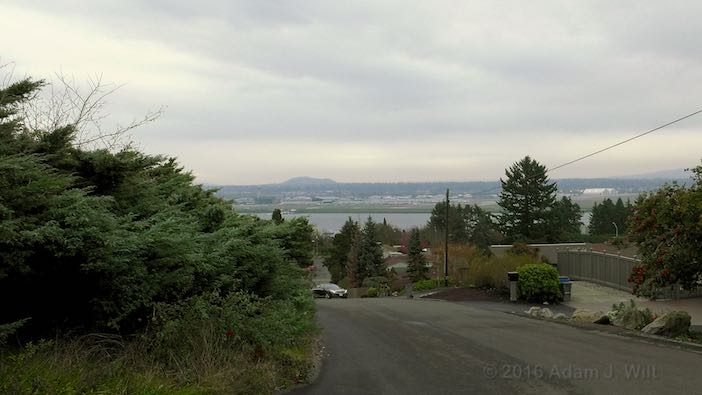
Fully wide

Full telephoto
Recording
The DVX200 records on SDHC / SDXC cards in AVCHD, MP4, and MOV formats. AVCHD is available for standard-def, 720p, and a variety of 1080i and 1080p recordings; MP4 and MOV are used to wrap higher-bitrate H.264 FHD, UHD, and 4K clips.
AVCHD clips range from 8 Mbps for 480i to 25 Mbps for 1080i/59.94.
MOV and MP4 FHD clips can be recorded as long-GOP at 50 Mbps or 100 Mbps, or as intraframe at 200 Mpbs.
UHD and 4K clips are captured as long-GOP at 100 Mbps, except for 2160p/50 and 2160p/59.94 which consume 150 Mbps. All clips are recorded with 4:2:0 color sampling and 8-bit depth.
Depending on the bitrate you’re recording, you’ll need class 4, class 10, UHS class 1, or UHS class 3 cards.
If the internal recording doesn’t meet your needs, you can always record offboard at higher quality, using an Atomos, Convergent Design, or Video Devices recorder.

DVX200 feeding a Video Devices PIX-E5 monitor/recorder
Frame Sizes and Scanning Rasters
The DVX200 uses a single 4/3” MOS sensor with a color filter array. Panasonic doesn’t specify the total photosite count of the sensor, but provides pixel counts for various imaging formats: 15.49 Mpixels for FHD, 13.35 Mpixels for 4K, 12.89 Mpixels for UHD 29.97, and so on. One thing is noteworthy: none of the quoted formats are native, pixel-for-pixel captures. Even the figure for UHD 59.94—8.71 Mpixels—is larger than the 8.29 Mpixels of a native UHD image.
“Fast Scan” UHD (2160p scan modes with less rolling shutter skew than “normal” UHD clips), 2160p/59.94, and 2160p/50 formats have a narrower viewing angle than the other UHD formats; 120fps VFR is narrower than other FHD images. Curious about what was going on, I set up the camera facing a test chart, and recorded a short clip in each of the available formats from FHD on up, without changing the zoom setting. I then superimposed still frames from each of the clips and resized them to align their images as needed:
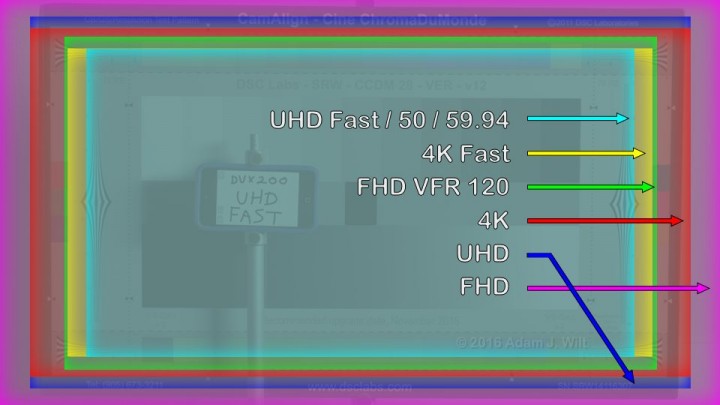
Yes, that’s six different scanning formats. And I didn’t check to see how 720p, 480i, and 576i were scanned, so there might be even more.
Something odd: Fast Scan UHD and 4K align as you might expect: they’re the same height, with 4K slightly wider (the final UHD image is 3840×2160 while 4K is 4096×2160). Those formats can use the same scale factors to generate their outputs from the source image. But “normal” UHD and 4K are the same width and different heights. That implies that different scaling factors are used for normal UHD and 4K clips.
Something odder: When I ran this past Barry Green, he confirmed the same-width 4K and UHD (as did Panasonic when I asked them about it), but he says that 4K, even though it has the same horizontal angle of view as UHD when zoomed in partially or fully, is still wider at full wide angle. I had already returned my camera to Panasonic when Barry discovered this, so I can’t test this myself. I can’t think of any reason why this would be so—it would also mean that the lens has a different, wider zoom ratio in 4K than in UHD—so I’m simply reporting his observation here for completeness. If I get a chance to test this in the future, I’ll update the article when I do so.
It’s also the case that the Megapixel numbers Panasonic gives for the various formats don’t match up with the relative scanning raster sizes shown in my test. It’s possible that the scanning rasters used before the 1.25 update were different, and better matched the quoted pixel counts, but I didn’t shoot any frame-size tests before updating the firmware, so I can’t say for certain what’s going on.
If we assume that the 50 Hz and 59.94 Hz UHD scanning didn’t change with version 1.25, then they (along with Fast Scan UHD) still use an 8.71 Mpixel area on the sensor, and still: not a single scanning format on this camera is pixel-for-pixel native (when I asked, Panasonic preferred not to divulge the actual scanned image sizes, but confirmed that every output format on the DVX200 is oversampled at the sensor and downsized for recording and output). The DVX200 isn’t a 4K camera; it’s a 5.2K-ish camera in which multiple output formats are generated using various non-native scanning rasters, all of them rescaled / resampled from the captured source image down to the final picture.
Resolution, Rendering, and Rolling Shutter
Given those varying scanning rasters and resampling ratios, one might well be concerned with the resolution and rendering quality of the resulting images. I put up the DSC Labs MegaTrumpet chart and shot 4K, FHD, and UHD; I also checked 480i and 720p on the Cine-ChromaDuMonde. Here are pixel-for-pixel extracts from the resulting clips, which were shot using the SCN 1 scene file with its default detail settings.
I also measured rolling shutter times (the elapsed time between the top of the image scan and the bottom) on fast pans of each format, averaging three different readings. My top-secret high-precision technique (hold a ruler against the screen and single-frame through clip, measuring the top and bottom positions of a moving vertical edge) yields measurements that are typically accurate only to +/-10% to +/-15%, so use my numbers as rough indicators of skew rather than definitive values.
“Normal” 4K: 4096x2160p at 24fps
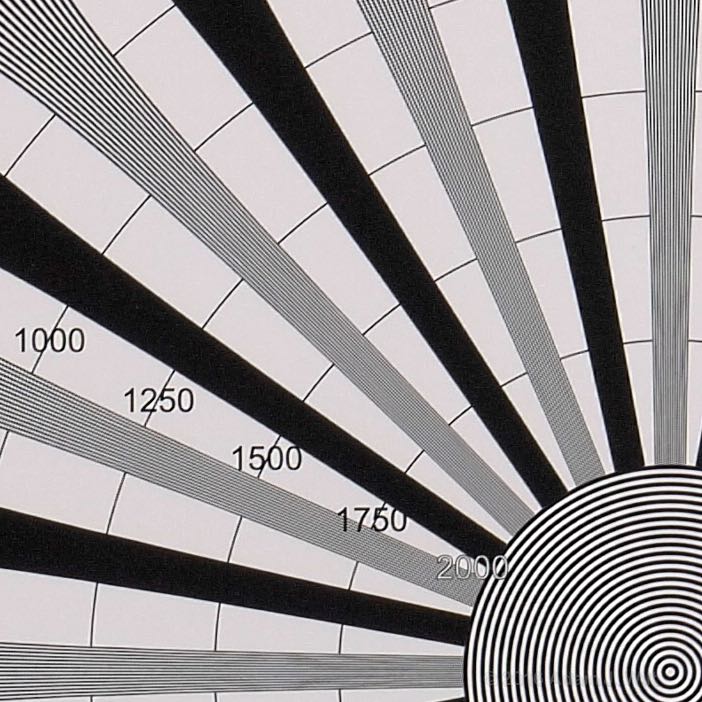
4K 24p, normal scan
Just looking at the horizontal and vertical trumpets, it looks like the crossover point between clean and aliased lines is around 1625 TVl/ph (TV lines per picture height). The general rule of thumb for a natively-scanned Bayer-pattern sensor is you’ll get an actual resolution about 75% of the pixel count, or 1620 TVl/ph, so the DVX200—however it’s making its image—is in line with natively-scanned 4K single sensors.
Rolling shutter time is about 1/43 sec.
“Normal” UHD: 3840x2160p up through 29.97 fps
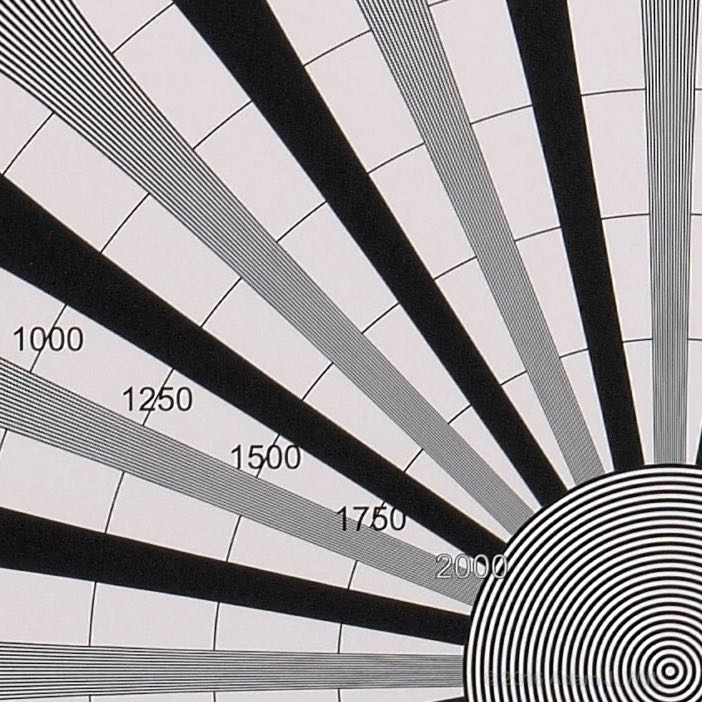
UHD, normal scan
This looks to me to be around 1750 TVl/ph. Remember how UHD is scanned the same width as 4K? Its scanned image is thus about 7% taller than the 4K image, and so should resolve about 7% more detail… and that’s pretty darned close to what we see here.
Rolling shutter is about 1/39 second, just slightly more than 7% slower than the 4K rolling shutter.
Fast Scan 4K: 4096x2160p @ 24fps
I didn’t measure this, sorry. As it’s the same scanned height as Fast Scan UHD, I’d expect it to perform identically on the resolution test, and be very similar in rolling shutter skew.
Fast Scan UHD: 3840x2160p at all rates (including 50 and 59.94)
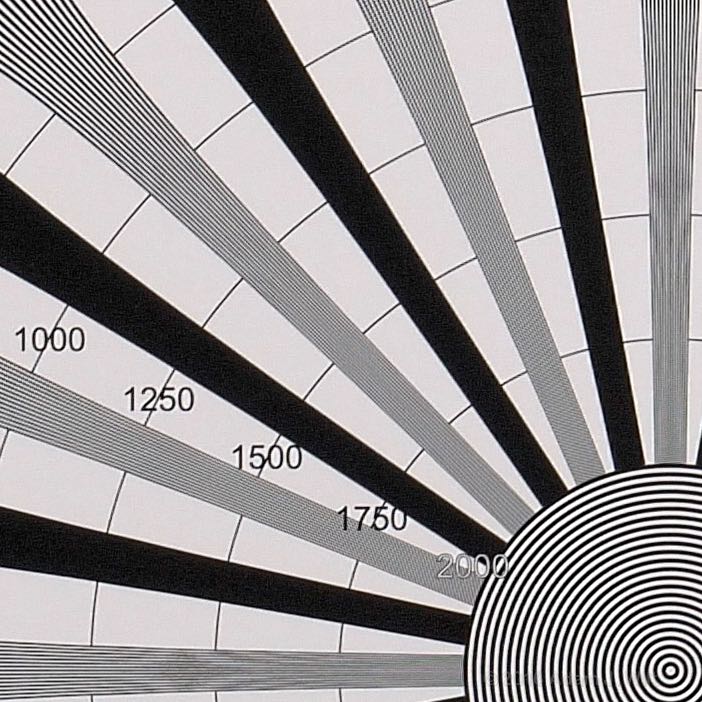
UHD, Fast Scan
Around 1440 TVl/ph or thereabouts, and with slightly more prominent aliasing than “normal” UHD: not quite as sharp, crisp, and clean, but not hugely worse.
The tradeoff is that rolling shutter skew is only half as bad: about 1/79 second. You can shake Fast Scan formats around twice as vigorously before their jellocam wobbles becomes objectionable.
FHD: 1920×1080, interlaced or progressive; VFR 2 – 60fps
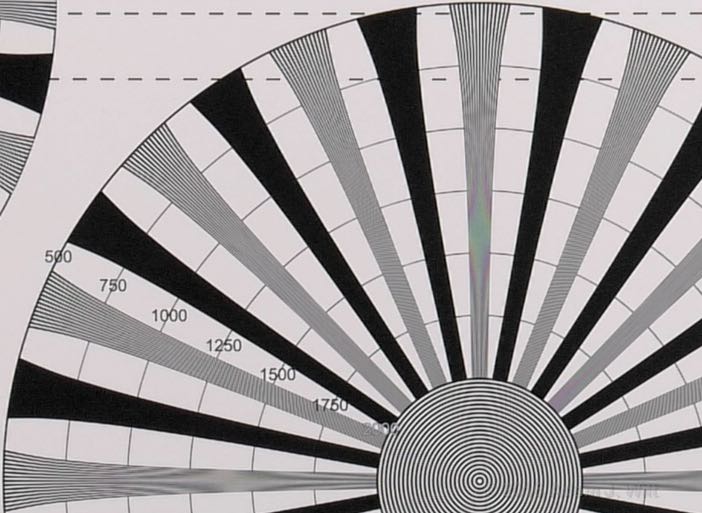
FHD 23.98p. Other rates and VFR through 60p look the same
FHD gives you something like 700 TVl/ph, with plenty of aliasing (and chroma moiré on vertical fine detail, too). It looks disappointing compared to the 4K and UHD images, but it’s still better than a GH4’s FHD. Remember also that the best you’ll ever see from a 1080p image is around 1080 TVl/ph (if you don’t mind plenty of aliasing above that level), with 800 TVl/ph more typical of real cameras.
Bear in mind that the real world doesn’t consist of test charts. The DVX200’s FHD holds up quite well in most situations, and if you’re not capturing a resolution-critical shot, shooting in FHD saves you a step in post—and lets you exploit the variable frame rate capability of the camera. VFR shots up through 60fps result in clips with the same resolution and rendering as normal-frame-rate FHD.
Even so, as with the GH4, you’ll get superior FHD by shooting UHD and downsizing it in post. The three following images are taken from a 1080p FCPX timeline:
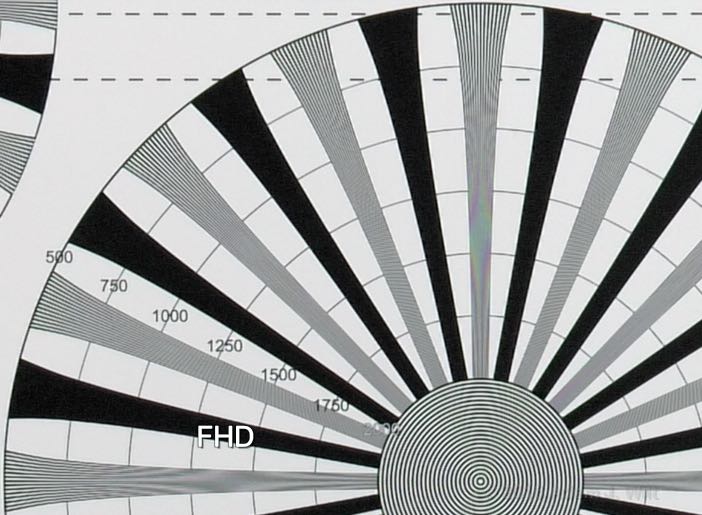
FHD (1080p), unscaled
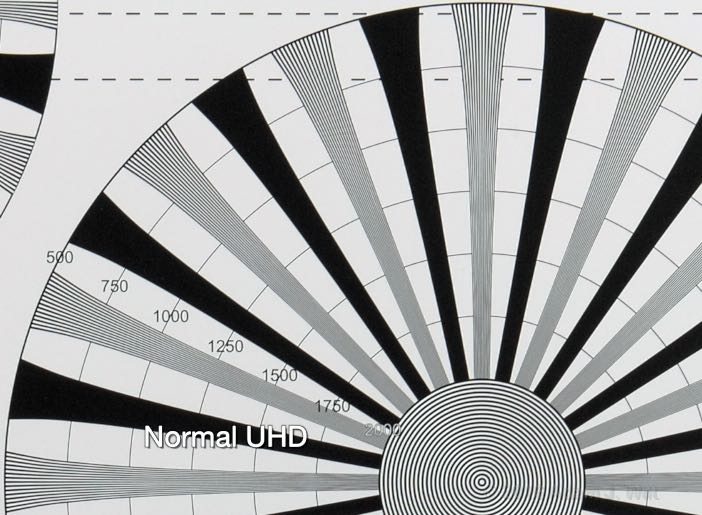
UHD, normal scan, downscaled to 1080p
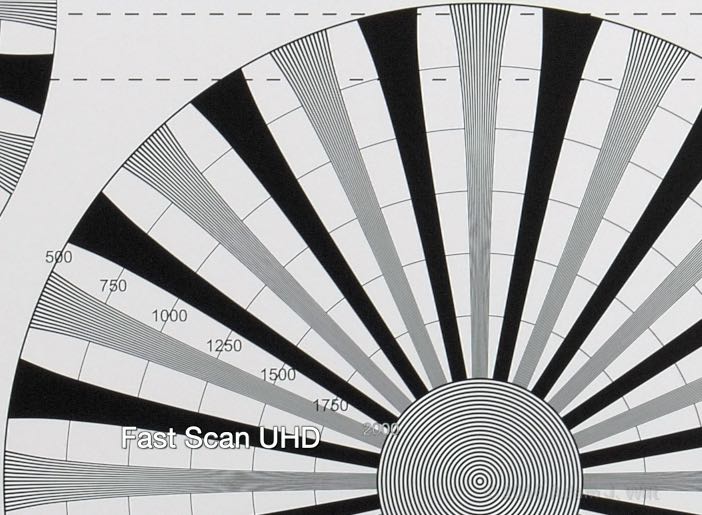
UHD, Fast Scan, downscaled to 1080p
(If you need 1080i, shoot 50p or 59.94p UHD and drop it into your 25i or 29.97i FHD timeline. If your NLE works properly, you’ll get a nicely-interlaced result. FCPX does this well; your mileage may vary.)
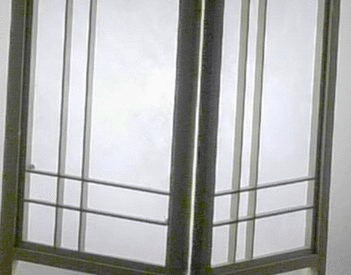
If you shoot FHD, you may see aliasing artifacts like those in the near-vertical, contrasty, sharp edges on this lamp (this a pixel-for-pixel extract from a larger shot). Those slight variations in line thickness and position are about as bad as it gets; it’s the sort of thing you can see if you’re looking for it and the subject matter is appropriate, but it’s not the sort of thing that disrupts a shot.
Rolling shutter is about 1/75 second for FHD, including VFR up through 60fps.
FHD VFR: 1920×1080 at 72 and 96fps
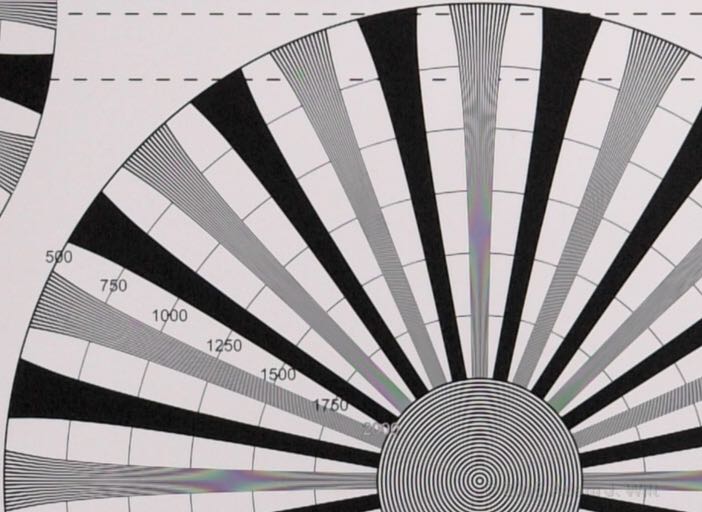
FHD VFR at 72fps
Variable Frame Rates 72fps and 96fps show roughly the same numbers on the chart, but clearly use a different demosaicing method; the images are slightly softer, vertically coarser, and show more chroma moiré.
Rolling shutter is around 1/127 second.
FHD VFR: 1920×1080 at 120fps
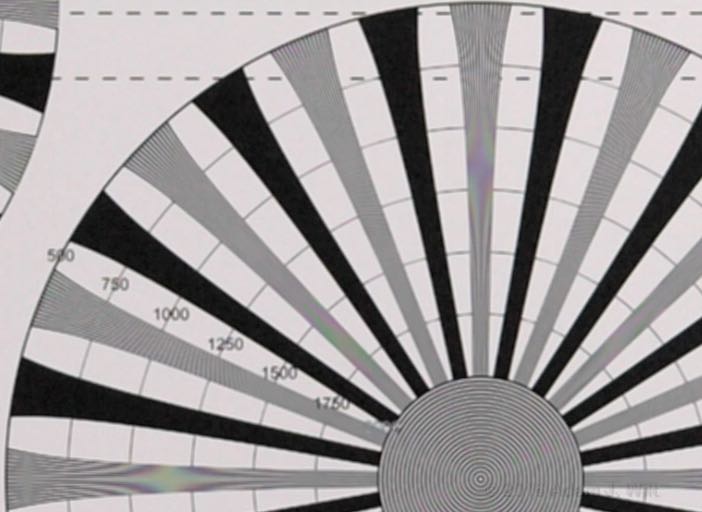
FHD VFR at 120fps
At 120fps, the angle of view narrows, nominal resolution drops to 580 TVl/ph, and the image degrades considerably, much more so than the numerical change would imply. It’s proof once again that there’s more to perceived sharpness, never mind overall picture quality, than resolution numbers alone can capture.
Rolling shutter is around 1/160 second.
720p: 1280x720p at 59.94fps
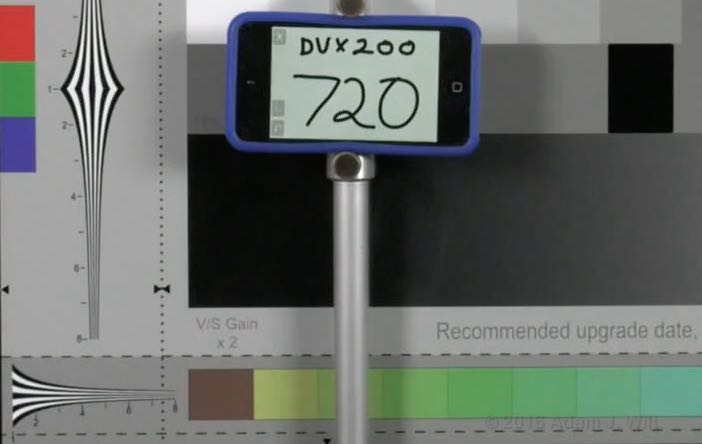
720p
720P resolves about 700 TVl/ph, with rolling shutter around 1/73 second.
480i: 720×480 interlaced at 29.97fps (59.94 fields/sec)
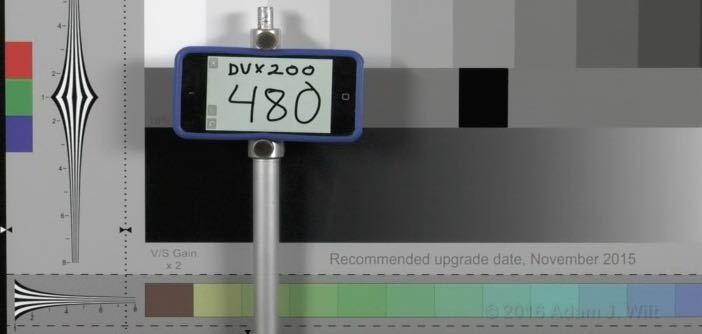
480i
480i resolves about 480 lines and suffers around 1/72 second rolling shutter.
Color and Tonal Scale
DVX200 color is Panasonic color, and that’s a good thing: generally speaking, it’s natural and accurate. The camera has a broadcast camera’s toolbox of color matrix and correction tweaks, whether it’s the choice of matrix (NORM1, the more saturated NORM2, FLUO for fluorescent lights, or CINE-LIKE), hue and saturation adjustments, or the full, sixteen-vector color corrector, so there’s plenty of room to play with the look if you don’t like the defaults.
The DVX200 offers seven standard gamma curves: HD, SD, three FILMLIKE choices, CINE-LIKE D (a flat rendering) and CINE-LIKE V (contrastier than D). You can also tweak black gamma, master pedestal, and several knee parameters.
The camera has a conventional straight-line knee for highlight compression, adjustable for overall level, slope, and knee point, but not for highlight saturation. When the knee kicks in, you’ll see hue shifts in bright, saturated areas, as in this daylight-lit wall shot with tungsten white balance:
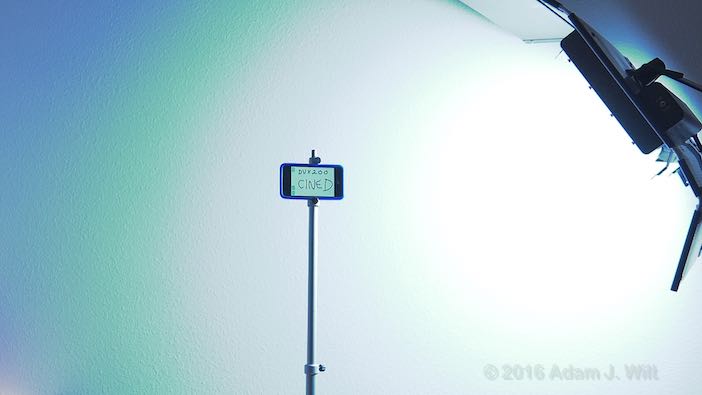
It’s perfectly normal as far as Rec.709-style video highlight rendering goes, but it may disappoint those looking for a more cinematic color rolloff, such as that found on an ARRI Alexa, a Sony in hypergamma mode, or even the GH4 with its marginally S-curved highlights.
The camera also has Panasonic’s V-Log L logarithmic tonal handling and muted color matrix, for those who want to do it all in post. There’s a Log View Assist, too: assign it to a button, press and hold that button, and the camera applies a viewing LUT to the displayed image. However, there’s no option to toggle the viewing LUT on and off; you need to hold the button down to use it [update: that was true with the version 1.25 firmware I tested. Barry Green tells me that it now stays on until you turn it off or start recording; and you can’t turn it on while recording]. It’s designed for a quick check, not for feeding client-friendly images downstream to video village.
Six “scene files” store combinations of color and tonal scale parameters as well as things like auto-iris levels, dynamic range stretch settings, and flash band compensation. To show some of the variations in rendering possible, I quickly shot the Cine-ChromaDuMonde chart under tungsten light using each of the six scene file settings. I foolishly assumed that the scene files were at their defaults instead of ensuring it by resetting the camera before I used it—so don’t look at the following screenshots as “here’s what the six scenes files do” but as “here’s what these six scene files do”!
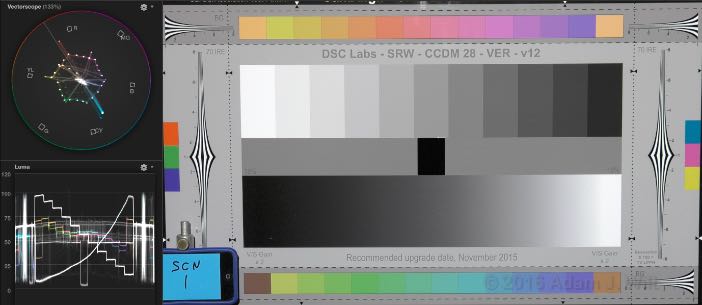
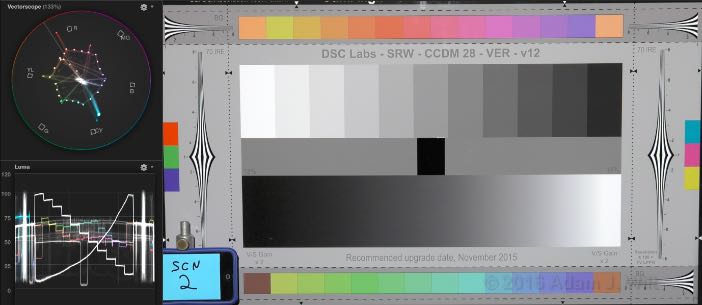
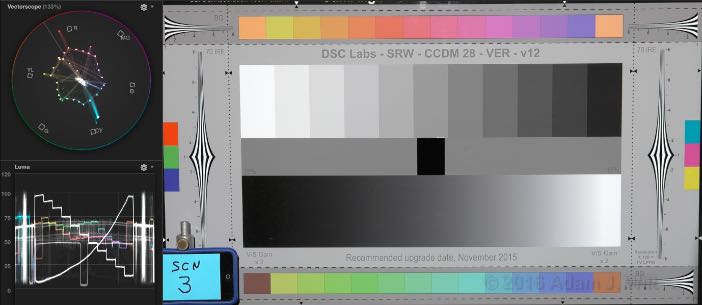
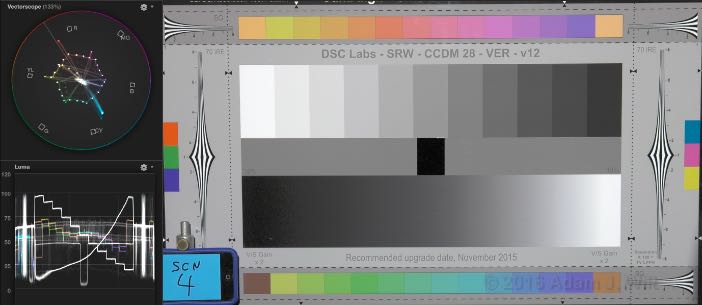
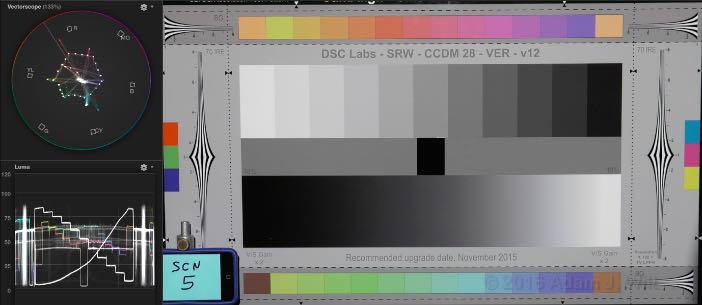
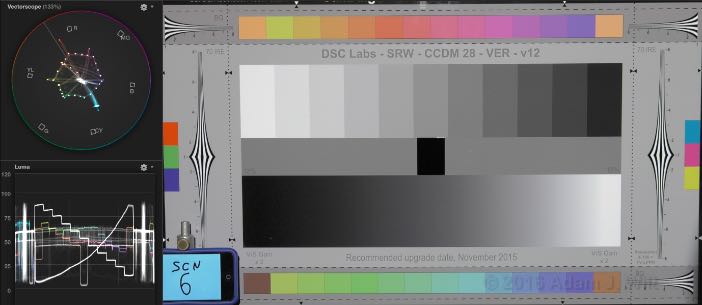
Here’s the same chart shot in V-Log L: as-is, with Panasonic’s VariCam 35 to Rec.709 LUT, and with a GH4 V-Log L to Rec.709 LUT generated using the Fujifilm IS-mini Color Space Converter.
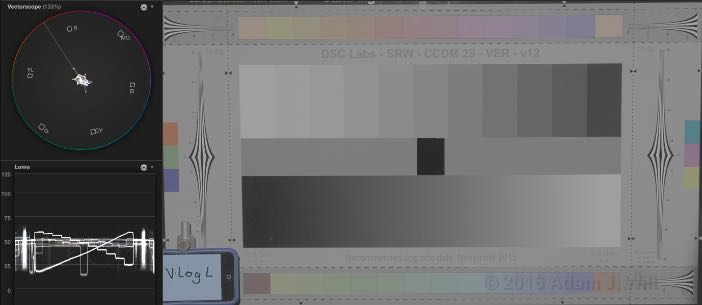
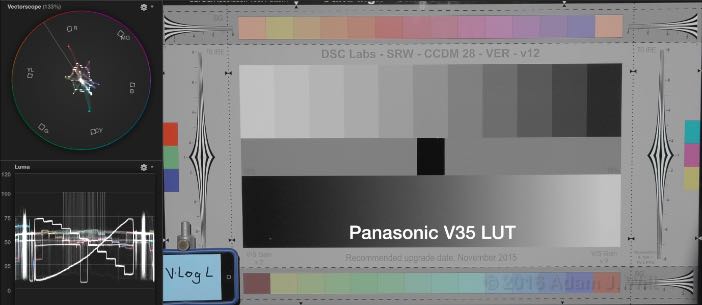
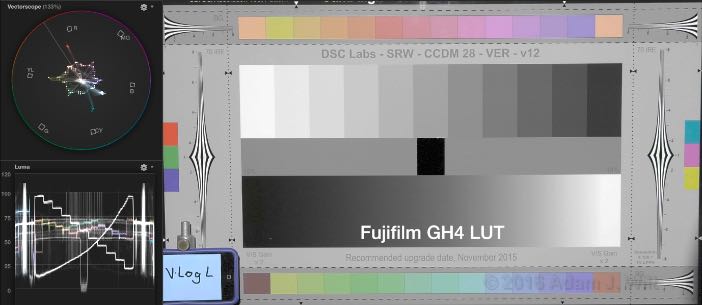
For more examples of DVX200 color, just type “DVX200 video” into your favorite search engine, and you’ll see plenty.
Dynamic Range
I aimed the DVX200 at the Xyla 21 to see what sort of dynamic range the camera had and what I could pull out of the shadows. I exposed to drive the top two patches into clipping, then counted how many one-stop steps it took to descend into darkness.
As shot, the DVX200 looks pretty much like any other camera, with about 8 stops in the normal gammas and 10 – 11 stops visible in V-Log L:

SCN 1 as shot, no color correction

V-Log L as shot, no color correction and no LUT applied
But with some massaging—adding in the Panasonic VariCam 35 LUT for the V-Log clip, and fiddling with the tonal scale on all the clips using Color Finale—more detail could be dragged out of the shadows.

Typical tonal-scale massaging to pull detail out of the shadows

SCN 1 with shadows stretched

SCN 6 with shadows stretched

V-Log L with the VariCam 35 LUT and shadows stretched
Overall, I saw 9+ recoverable stops in SCN 1 through SCN 4, 10 stops for SCN 5, 10+ stops in SCN 6, and 12+ stops for V-Log L. When I say “recoverable” I mean “you can dig this out if you need it, but you may see more noise than you like in the shadows when you do so.” Determining the degree to which this level of digging is tolerable is left as an exercise for the reader.
V-Log is noisier in the shadows than the other clips, but bear in mind you can dig a couple of stops deeper into it, too. Even so, it’s noticeably cleaner in V-Log than the GH4 is, not just in the shadows but over the entire tonal scale. Indeed, it’s clean enough that stairstepping / quantizing is visible on 8-bit V-Log gradients: this is one camera where adding an external 10-bit recorder is a no-brainer for log work.
Sensitivity and Gain
The DVX200 is rated at ISO 500 for 0dB gain. Sensitivity can be boosted to 24dB / ISO 8000 in normal gain modes, or 36dB / ISO 32,000 in “super gain” modes. As you increase sensitivity, the image degrades in a fairly natural and linear manner; there isn’t a breakpoint where the image suddenly changes due to aggressive noise reduction as on (for example) the Canon XC10. The following samples are full-size crops from UHD clips. These are worst-case images; if you downsize them to FHD, or shoot FHD to begin with, you’ll see less noise than shown here.
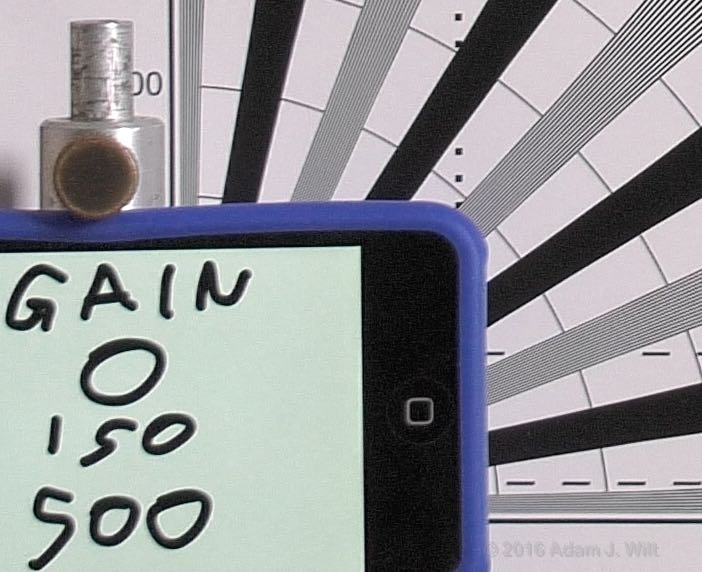
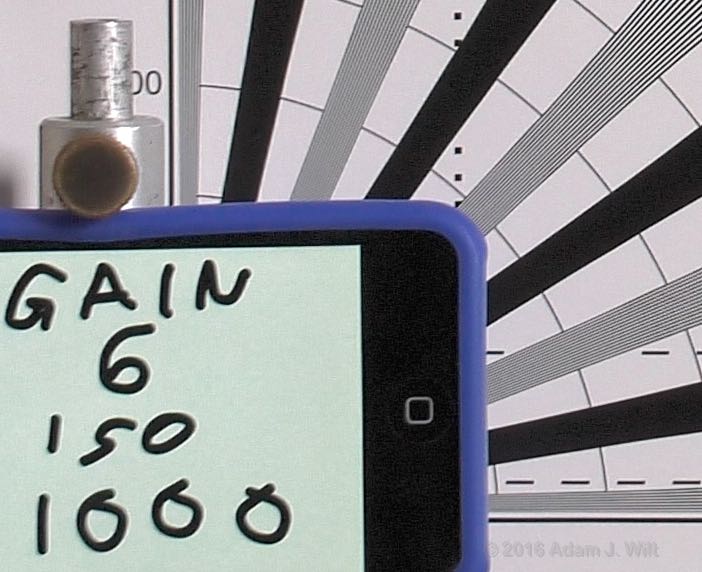
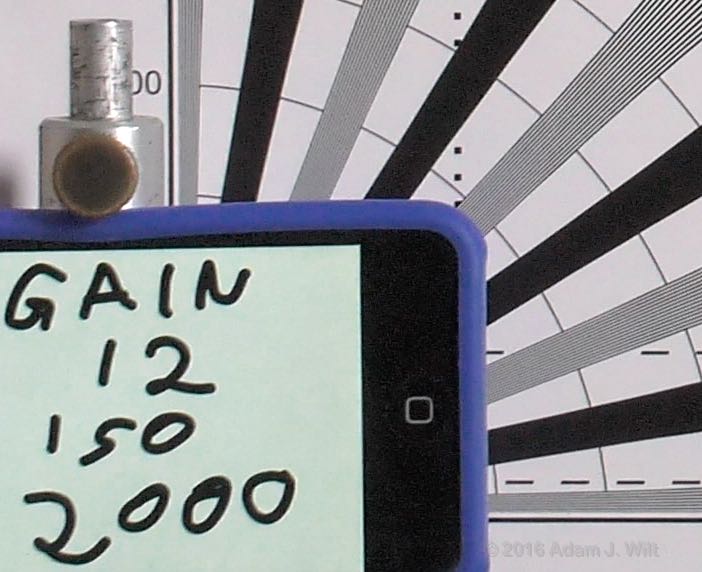
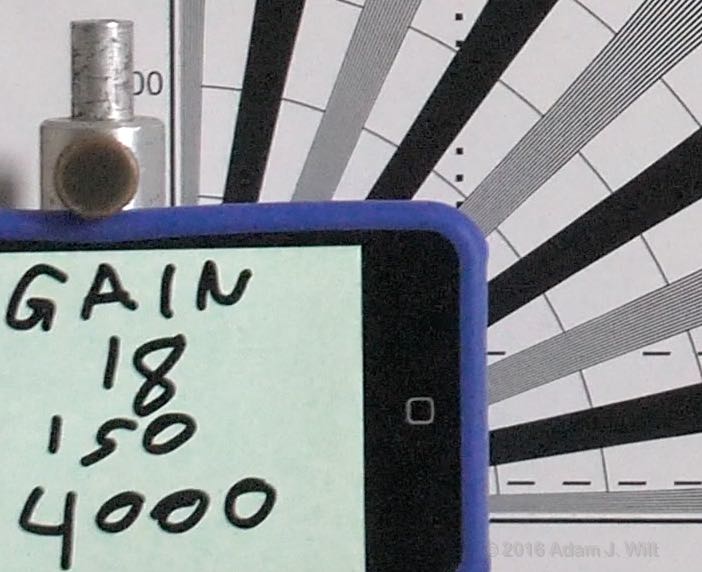
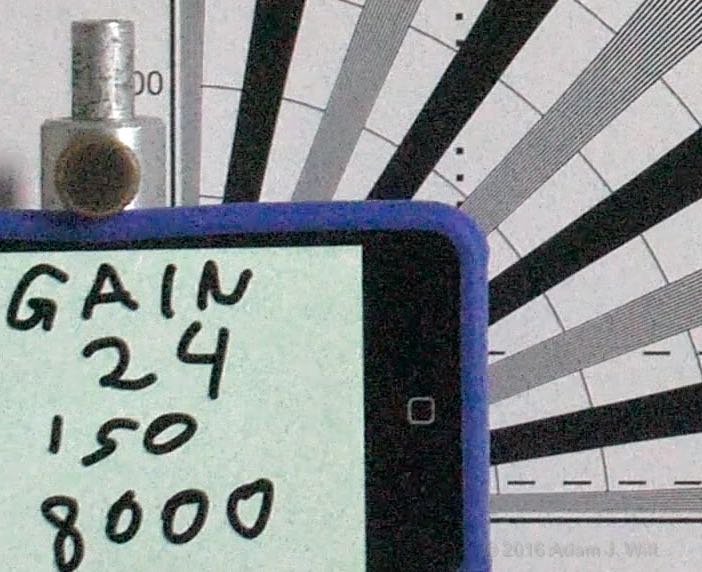
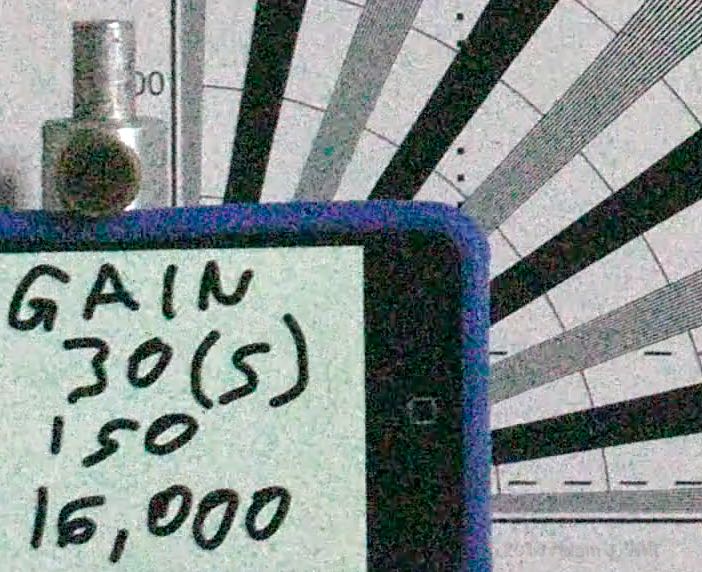
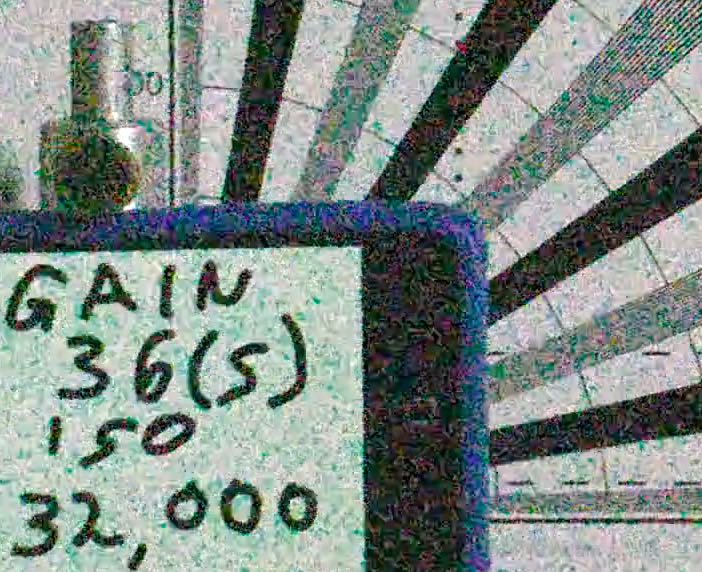
At all sensitivities there’s evidence of recursive (a.k.a. 3D) noise reduction, visible on fast pans with contrasty images as a faint ghost of the preceding frame or two:
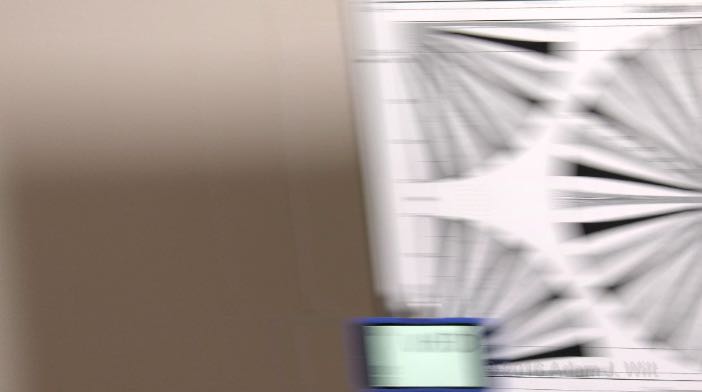
Again, this is something I went out of my way to reveal; it’s not something you’re likely to notice in most shooting situations.
Audio
I did some desultory recording with the built-in mikes, but didn’t test audio in detail. The sound I did record was crisp and clear, but—as with all built-in mikes—any sort of aggressive camera handling was picked up: fast power zooms, fingers sliding across the lens barrel, and sudden switch flipping all left their audible mark.
Conclusion
The DVX200 packs a lot of flexibility and functionality into a $4200 package, and makes remarkably few compromises in doing so: It doesn’t genlock. The lens loses 1⅓ stop zooming in, and you can’t swap it for a different lens. If FHD quality is paramount, you’ll do better with one of Panasonic’s 1/3” 3-chip HD-native camcorders (or with shooting UHD on the DVX200 and downscaling in post). And it’s a big, side-heavy beast that’s not for the faint of heart or weak of wrist when handholding is demanded.
But if you can live with those limitations, the camera offers you a metric ton of capability: true 24fps 4K, UHD up to 60p, FHD, and even 720p and standard-def, right down to an analog composite output. 10-bit output for offboard recording, or 8-bit internal recording on low-cost SD cards. A 13x zoom that makes a suspiciously rectilinear, aberration-free image (yes, the camera probably cheats and fixes the image in software, but if the end result is a good picture, who am I to complain?). Variable frame rates, infrared imaging, dual-format recording, still-image capture while shooting or in playback, pre-record, forensic timestamp burn-in, timelapse. Gain or ISO, shutter speed or angle, feet or meters, fast or slow or variable-rate focusing. Good-looking color, and almost infinitely tweakable, too. Multiple gammas and log recording. Fully manual operations or fully automatic or anywhere in-between.
The original DVX100 cost $3795 in 2002. In today’s money, that would be $5080. The DVX200 costs less and does more—a lot more. Also: it’s red! And looks like carbon fiber! What’s not to like?
True, you probably won’t see DVX200s taking over the rental houses and lensing tentpole features. But it’s a $4200 camcorder, for cryin’ out loud, not an Alexa, F55, or VariCam 35 costing 10x–20x as much (once you include glass). “You get what you pay for” is still the rule; the trick is to get as much as you can for a given lump of cash, and the DVX200 does very well indeed in that regard.
Pros
- Every common imaging format from 480i to 4K 24p
- 1080p and 2160p at 50fps and 59.94 fps
- Still photo capture, even while recording; still capture from recorded clips
- 4/3” sensor allows decent depth-of-field control without making on-the-fly focusing impossible
- Very good 13x lens for the money
- “Worldcam” 50Hz/60Hz flexibility; multiple frame rates; VFR from 2–120fps
- Inexpensive SDHC / SDXC card internal recording
- 10-bit 4:2:2 outputs for offboard recording
- Panasonic color with comprehensive tweakability
- Multiple standard gammas plus V-Log L
- 9+ to 12+ stops of dynamic range depending on shooting mode.
- 12 user-assignable buttons
- Highly customizable control functions
- High-res LCD & EVF with good detail, peaking, and magnification functions
- Realtime, detailed waveform and vectorscope displays; histogram; spotmeter
- Flexible touchscreen or thumbwheel navigation
Cons
- FHD recordings comparatively soft and aliased
- Very side-heavy; hard to handhold for long without support
- Slight lag in focus ring response
- Wide-open lens loses 1⅓ stop through zoom range
Cautions
- Angle of view changes depending on format and frame rate; check your framing after changing modes.
- Camera’s flexibility leads to complexity: read the operating instructions carefully before plunging into a production.
- Maximum aperture of f/2.8–4.5 limits extremely shallow depth-of-field effects
- No “cinematic” highlight handling (e.g., hypergamma, highlight desaturation)
- Camera can jam-sync timecode, but can’t genlock
- Bright red side panel makes inconspicuous run ‘n’ gun difficult
More info:
Operating instructions Vol 1 (10.6 MB PDF via ftp)
Operating instructions Vol 2 (9.6 MB PDF via ftp)
Barry Green’s Guide to the DVX200 (give Pannasonic your email, and they’ll give you access to the 29 MB PDF)
Jon Fauer’s Panasonic Yamagata Lens Factory Tour, including background on the DVX200 and its lens
Disclosures: I asked Panasonic to send me a DVX200 for review, and they did, but I had to send it back when I was done (Panasonic paid shipping in both directions). Panasonic has not offered me any compensation or material consideration for the review and has not pressured me in any way for a favorable writeup. Panasonic reviewed this article for technical accuracy, supplied the image of the magnesium frame casting, and answered questions about carbon fiber and paint finishes, but did not request any changes in my presentation or conclusions.
DSC Labs has lent me various charts and I’ve purchased others from them at list price, and I’ve worked their booth at NAB, but they haven’t influenced me to use their charts in ways I wouldn’t have already.
I have the PIX-E5 recorder on indefinite loan from Video Devices as I helped develop its software and still beta-test new features for it.
I have no relationship with IDX, DVTEC, Protech, or Acebil.
I bought the DVX100 and GH4 with my own money at market prices.
